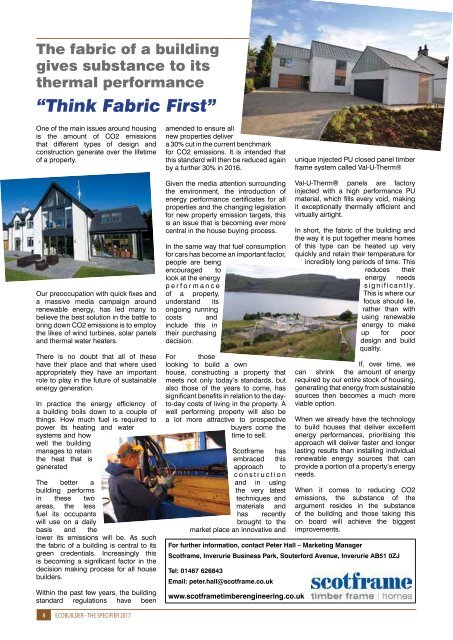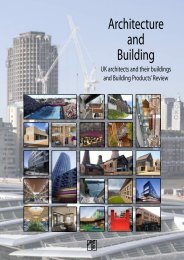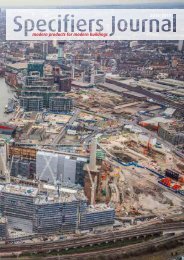Specifiers Journal 2017
Specifiers Journal 2017
Specifiers Journal 2017
Create successful ePaper yourself
Turn your PDF publications into a flip-book with our unique Google optimized e-Paper software.
The fabric of a building<br />
gives substance to its<br />
thermal performance<br />
“Think Fabric First”<br />
One of the main issues around housing<br />
is the amount of CO2 emissions<br />
that different types of design and<br />
construction generate over the lifetime<br />
of a property.<br />
amended to ensure all<br />
new properties deliver<br />
a 30% cut in the current benchmark<br />
for CO2 emissions. It is intended that<br />
this standard will then be reduced again<br />
by a further 30% in 2016.<br />
unique injected PU closed panel timber<br />
frame system called Val-U-Therm®<br />
Our preoccupation with quick fixes and<br />
a massive media campaign around<br />
renewable energy, has led many to<br />
believe the best solution in the battle to<br />
bring down CO2 emissions is to employ<br />
the likes of wind turbines, solar panels<br />
and thermal water heaters.<br />
There is no doubt that all of these<br />
have their place and that where used<br />
appropriately they have an important<br />
role to play in the future of sustainable<br />
energy generation.<br />
In practice the energy efficiency of<br />
a building boils down to a couple of<br />
things. How much fuel is required to<br />
power its heating and water<br />
systems and how<br />
well the building<br />
manages to retain<br />
the heat that is<br />
generated<br />
The better a<br />
building performs<br />
in these two<br />
areas, the less<br />
fuel its occupants<br />
will use on a daily<br />
basis and the<br />
lower its emissions will be. As such<br />
the fabric of a building is central to its<br />
green credentials. Increasingly this<br />
is becoming a significant factor in the<br />
decision making process for all house<br />
builders.<br />
Within the past few years, the building<br />
standard regulations have been<br />
4 ECOBUILDER - THE SPECIFIER <strong>2017</strong><br />
Given the media attention surrounding<br />
the environment, the introduction of<br />
energy performance certificates for all<br />
properties and the changing legislation<br />
for new property emission targets, this<br />
is an issue that is becoming ever more<br />
central in the house buying process.<br />
In the same way that fuel consumption<br />
for cars has become an important factor,<br />
people are being<br />
encouraged to<br />
look at the energy<br />
performance<br />
of a property,<br />
understand its<br />
ongoing running<br />
costs and<br />
include this in<br />
their purchasing<br />
decision.<br />
For those<br />
looking to build a own<br />
house, constructing a property that<br />
meets not only today’s standards, but<br />
also those of the years to come, has<br />
significant benefits in relation to the dayto-day<br />
costs of living in the property. A<br />
well performing property will also be<br />
a lot more attractive to prospective<br />
buyers come the<br />
time to sell.<br />
Scotframe has<br />
embraced this<br />
approach to<br />
construction<br />
and in using<br />
the very latest<br />
techniques and<br />
materials and<br />
has recently<br />
brought to the<br />
market place an innovative and<br />
Val-U-Therm® panels are factory<br />
injected with a high performance PU<br />
material, which fills every void, making<br />
it exceptionally thermally efficient and<br />
virtually airtight.<br />
In short, the fabric of the building and<br />
the way it is put together means homes<br />
of this type can be heated up very<br />
quickly and retain their temperature for<br />
incredibly long periods of time. This<br />
reduces their<br />
energy needs<br />
significantly.<br />
This is where our<br />
focus should lie,<br />
rather than with<br />
using renewable<br />
energy to make<br />
up for poor<br />
design and build<br />
quality.<br />
If, over time, we<br />
can shrink the amount of energy<br />
required by our entire stock of housing,<br />
generating that energy from sustainable<br />
sources then becomes a much more<br />
viable option.<br />
When we already have the technology<br />
to build houses that deliver excellent<br />
energy performances, prioritising this<br />
approach will deliver faster and longer<br />
lasting results than installing individual<br />
renewable energy sources that can<br />
provide a portion of a property’s energy<br />
needs.<br />
When it comes to reducing CO2<br />
emissions, the substance of the<br />
argument resides in the substance<br />
of the building and those taking this<br />
on board will achieve the biggest<br />
improvements.<br />
For further information, contact Peter Hall – Marketing Manager<br />
Scotframe, Inverurie Business Park, Souterford Avenue, Inverurie AB51 0ZJ<br />
Tel: 01467 626843<br />
Email: peter.hall@scotframe.co.uk<br />
www.scotframetimberengineering.co.uk<br />
Building using<br />
our high<br />
thermal performance, airtight, closed panel<br />
timber frame systems for floors, walls &<br />
roofs minimises the requirement for mirco<br />
renewable technologies by embracing<br />
‘Fabric First’ principles.<br />
AIRTIGHTNESS<br />
THERMAL<br />
PERFORMANCE<br />
ENERGY<br />
EFFICIENCY<br />
Cumbernauld 01236 861200<br />
Inverurie 01467 624440<br />
Dundee 01382 561772<br />
Inverness 01463 717328<br />
Paignton 01803 267680<br />
West Sussex 01273 831896<br />
www.scotframe.co.uk<br />
SPEED OF<br />
CONSTRUCTION<br />
Let Scotframe<br />
thermally engineer<br />
a solution for you.







